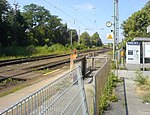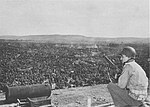Aplerbeck

Aplerbeck is a borough (Stadtbezirk) of the city of Dortmund in the Ruhr district of North Rhine-Westphalia, Germany. Since 1929, it has been a suburb of Dortmund, located in the city's south-east. The river Emscher, a tributary of the Ruhr, crosses Aplerbeck. Aplerbeck was first documented as a village in 899. The place is associated with the death of two martyrs both named Ewald in the 7th century, according to the Golden Legend. Aplerbeck was the location of mining and heavy industry as part of the Ruhr from the 19th century to 1926, resulting in a larger population and the building of a representative town hall and a larger church. A psychiatric hospital of regional importance, founded in 1890, is still in operation, now as LWL-Klinik Dortmund.
Excerpt from the Wikipedia article Aplerbeck (License: CC BY-SA 3.0, Authors, Images).Aplerbeck
Aplerbecker Marktplatz, Dortmund Aplerbeck (Aplerbeck)
Geographical coordinates (GPS) Address Website Nearby Places Show on map
Geographical coordinates (GPS)
| Latitude | Longitude |
|---|---|
| N 51.491666666667 ° | E 7.5555555555556 ° |
Address
Mercator Bücherschrank
Aplerbecker Marktplatz
44287 Dortmund, Aplerbeck (Aplerbeck)
North Rhine-Westphalia, Germany
Open on Google Maps









